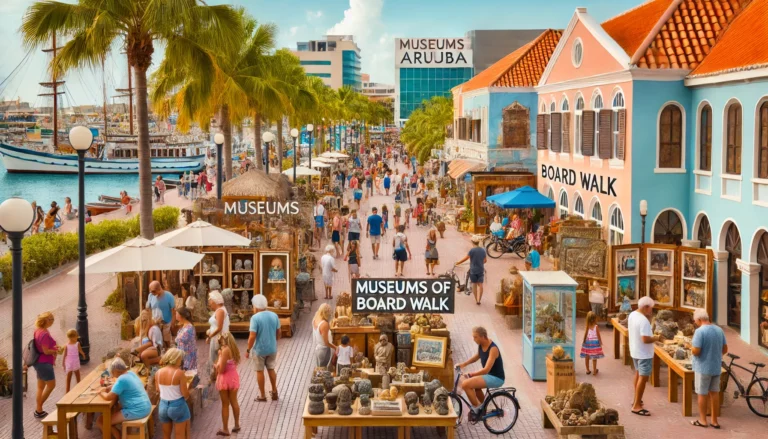Why visit the museums of Aruba Board Walk
Discover the Cultural Treasures of Aruba Board Walk
Welcome to the vibrant Aruba Board Walk, where stunning natural beauty meets rich cultural heritage. As your guide from Arubaboardwalk, I am excited to take you on an exploration of the fascinating museums that dot our beautiful island. In this blog post, we will delve into the reasons why these museums are must-visit destinations, offering insights into Aruba’s history, art, and culture. Whether you’re a history buff, an art lover, or simply curious about the island’s heritage, this guide will provide you with all the information you need for an enriching museum experience.
The Allure of Aruba’s Museums
Aruba Aloe Museum and Factory
The Aruba Aloe Museum and Factory is a testament to the island’s rich agricultural history. Established in 1890, this museum offers a comprehensive look at the cultivation and processing of aloe vera, one of Aruba’s most significant exports. Visitors can tour the factory, learn about the benefits of aloe, and even sample some of the products. It’s a unique experience that combines education with a touch of wellness.
National Archaeological Museum of Aruba
The National Archaeological Museum of Aruba is a treasure trove of artifacts that tell the story of the island’s indigenous peoples. The museum’s exhibits range from ancient pottery to tools and jewelry, providing a glimpse into the lives of Aruba’s earliest inhabitants. The beautifully restored colonial building that houses the museum is an attraction in itself, adding to the charm of your visit.
Museum of Industry
Located in the heart of San Nicolas, the Museum of Industry celebrates Aruba’s industrial heritage. The museum highlights the island’s economic evolution, from gold mining and aloe production to the oil refinery and tourism industries. It’s a fascinating journey through time, showcasing the resilience and innovation of the Aruban people.
Activities to Enjoy at Aruba’s Museums
1. Interactive Exhibits
Many of Aruba’s museums feature interactive exhibits that engage visitors of all ages. From hands-on displays at the Aruba Aloe Museum to multimedia presentations at the Museum of Industry, these interactive elements make learning about Aruba’s history and culture a fun and immersive experience.
2. Guided Tours
Enhance your museum visit with a guided tour. Knowledgeable guides provide in-depth insights into the exhibits, sharing fascinating stories and little-known facts about Aruba’s heritage. Whether you’re exploring the National Archaeological Museum or the Museum of Industry, a guided tour can enrich your understanding and appreciation of the exhibits.
3. Workshops and Demonstrations
Many museums offer workshops and demonstrations that allow visitors to get a hands-on experience. At the Aruba Aloe Museum, you can see how aloe products are made, while the National Archaeological Museum often hosts pottery and weaving demonstrations. These activities provide a deeper connection to the island’s cultural traditions.
4. Special Exhibitions
Keep an eye out for special exhibitions that rotate through Aruba’s museums. These temporary displays often focus on specific aspects of Aruban culture or history, offering fresh and intriguing perspectives. Whether it’s a photography exhibit or a showcase of contemporary Aruban art, there’s always something new to discover.
5. Gift Shops
No museum visit is complete without a stop at the gift shop. Aruba’s museum gift shops offer a variety of unique souvenirs, from locally made crafts to books and replicas of artifacts. It’s the perfect place to pick up a memento of your visit or a special gift for someone back home.
When planning your visit to Aruba, make sure to include the museums of Aruba Board Walk in your itinerary. These museums offer a deep dive into the island’s rich cultural heritage, with exhibits that range from archaeological artifacts to industrial history. Engaging activities such as interactive exhibits, guided tours, and workshops provide a hands-on learning experience that is both educational and entertaining. Explore the diverse history and culture of Aruba through its museums, and gain a comprehensive understanding of what makes this island so unique.
Essential Tips for Visiting Aruba’s Museums
1. Plan Ahead
Check the museum’s opening hours and any special events or exhibitions that might be happening during your visit. Some museums may have seasonal hours or be closed on certain days, so planning ahead ensures you won’t miss out.
2. What to Bring
- Comfortable Clothing: Museums can involve a lot of walking, so wear comfortable clothes and shoes.
- Camera: Capture your favorite exhibits and moments, but remember to check the museum’s photography policy.
- Notebook and Pen: If you’re a history enthusiast or student, taking notes can be helpful for remembering key facts and details.
3. Respect the Exhibits
While it can be tempting to touch displays, especially interactive ones, always follow the museum’s rules regarding exhibits. This helps preserve the artifacts and ensures a quality experience for all visitors.
Conclusion
Visiting the museums of Aruba Board Walk is a journey through the island’s rich and diverse heritage. From the ancient artifacts at the National Archaeological Museum to the industrial milestones showcased at the Museum of Industry, these institutions offer a window into Aruba’s past and present. Whether you’re exploring the process of aloe production at the Aruba Aloe Museum or delving into the history of the island’s industries, each museum provides a unique and engaging experience.
The museums of Aruba Board Walk are not just about looking at artifacts; they offer interactive exhibits, guided tours, workshops, and special exhibitions that bring the island’s history and culture to life. These activities make the museums a perfect destination for visitors of all ages, providing both education and entertainment.
FAQs
1. Are the museums suitable for children?
Absolutely! Many of Aruba’s museums have interactive exhibits and activities that are perfect for children, making them an educational and fun outing for the whole family.
2. Is there an entrance fee for the museums?
Entrance fees vary by museum. Some museums, like the National Archaeological Museum, have a nominal fee, while others, like the Aruba Aloe Museum, may include guided tours in the ticket price. Check the museum’s website for specific details.
3. Can I take photos in the museums?
Most museums allow photography, but it’s best to check the specific museum’s policy. Some exhibits may have restrictions to protect delicate artifacts.
4. Are there dining options near the museums?
Yes, many museums are located near cafes and restaurants where you can enjoy a meal or snack before or after your visit. Some museums also have on-site cafes.
5. Do the museums offer multilingual tours?
Many museums offer tours in multiple languages, including English, Spanish, and Dutch. Check with the museum in advance to see if tours in your preferred language are available.
By now, you should have a comprehensive understanding of why visiting the museums of Aruba Board Walk is a must-do activity. These museums provide a rich tapestry of the island’s history and culture, offering engaging and educational experiences for all visitors. Plan your visit today and immerse yourself in the fascinating world of Aruba’s museums. Whether you’re a history enthusiast, an art lover, or simply curious about the island’s heritage, the museums of Aruba Board Walk promise an unforgettable journey into the heart of Aruba.




